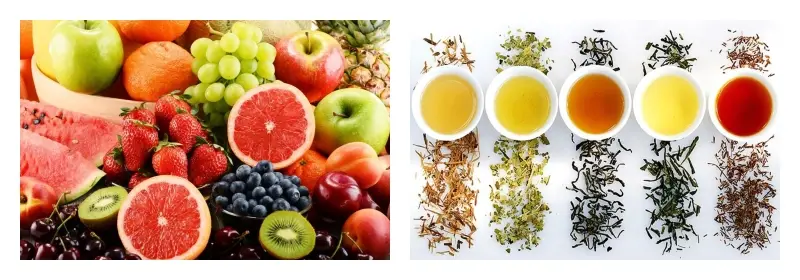what are polyphenols?
2024-08-21 12:19:35
What are Polyphenols?
Polyphenols powder are a differing gather of normally happening compounds found in plants. They are characterized by having numerous phenol (fragrant liquor) bunches in their chemical structure. Polyphenols are copious in natural products, vegetables, entirety grains, tea, coffee, wine, chocolate, and other plant-derived foods.
There are thousands of diverse polyphenols, and they can be encourage classified into a few subclasses based on their structure, counting flavonoids, phenolic acids, lignans, and stilbenes. A few common dietary polyphenols include:
Flavonoids: Flavonoids are the biggest subclass of polyphenols and are found in numerous natural products, vegetables, and refreshments such as tea and ruddy wine. Illustrations incorporate quercetin, catechins, anthocyanins, and flavonols.
Phenolic Acids: Phenolic acids are found in a assortment of plant nourishments and are especially copious in natural products, vegetables, and entirety grains. Cases incorporate caffeic corrosive, ferulic corrosive, and chlorogenic acid.
Lignans: Lignans are found in seeds, entire grains, nuts, and a few natural products and vegetables. Flaxseeds are especially wealthy in lignans.
Stilbenes: Stilbenes are less common in the slim down but are found in certain nourishments such as grapes, peanuts, and ruddy wine. The most well-known stilbene is resveratrol.
Polyphenols have pulled in significant consideration due to their potential wellbeing benefits. Inquire about recommends that polyphenols have antioxidant, anti-inflammatory, anti-diabetic, and cardioprotective properties. They may too bolster cognitive work, advance intestine wellbeing, and contribute to in general well-being.
The wellbeing benefits of polyphenols are thought to emerge from their capacity to rummage free radicals, decrease oxidative push, tweak fiery pathways, and connected with different cellular signaling pathways. Be that as it may, it's imperative to note that the bioavailability and natural movement of polyphenols can shift broadly depending on components such as nourishment framework, handling, and person contrasts in metabolism.
Including a assortment of polyphenol-rich nourishments in your count calories, such as natural products, vegetables, entire grains, nuts, seeds, tea, and ruddy wine (in control), may contribute to by and large wellbeing and well-being.
Understanding Polyphenols: Nature's Bioactive Molecules
Polyphenols powderare a diverse group of naturally occurring compounds characterized by the presence of multiple phenol (aromatic alcohol) groups. Found abundantly in plants, these bioactive molecules serve various functions, including defense against environmental stressors like UV radiation and pathogens.
Exploring Sources of Polyphenols: From Fruits to Tea Leaves
Polyphenols are abundant in various foods, including fruits and tea leaves. Let's explore some common sources:
Fruits:
Berries: Berries such as strawberries, blueberries, raspberries, and blackberries are rich in polyphenols, particularly flavonoids like anthocyanins and flavonols.
Apples: Apples contain various polyphenols, including flavonoids like quercetin and catechins.
Citrus Fruits: Citrus fruits like oranges, lemons, and grapefruits contain flavonoids such as hesperidin and naringin.
Grapes: Grapes, especially in their skins, are rich in polyphenols, including resveratrol, flavonoids, and phenolic acids.
Tea Leaves:
Green Tea: Green tea is renowned for its high polyphenol content, particularly catechins such as epigallocatechin gallate (EGCG), epicatechin gallate (ECG), epigallocatechin (EGC), and epicatechin (EC). These catechins contribute to green tea's antioxidant and health-promoting properties.
Black Tea: While black tea undergoes oxidation during processing, it still contains polyphenols, including theaflavins and thearubigins, which contribute to its flavor and potential health benefits.
White Tea: White tea is made from young tea leaves and buds and is minimally processed, retaining high levels of polyphenols similar to green tea.
Other Sources:
Red Wine: Red wine contains polyphenols such as resveratrol, flavonoids, and phenolic acids, derived from the skins and seeds of grapes. Moderate consumption of red wine has been associated with potential health benefits, attributed in part to its polyphenol content.
Chocolate: Dark chocolate, in particular, is rich in polyphenols, including flavonoids like catechins, flavonols like quercetin, and others. Cocoa beans, the primary ingredient in chocolate, contain various polyphenols that contribute to its antioxidant properties.
Incorporating a diverse array of polyphenol-rich foods into your diet, such as fruits, tea, red wine, and dark chocolate, can provide numerous health benefits due to their antioxidant and anti-inflammatory properties. Additionally, opting for minimally processed forms of these foods can help maximize their polyphenol content.

Unveiling the Health Benefits of Polyphenols: Antioxidant Powerhouses
One of the most celebrated attributes of Polyphenols powderis their potent antioxidant activity. By scavenging free radicals and neutralizing oxidative stress, these compounds play a pivotal role in mitigating cellular damage and reducing the risk of chronic diseases such as cardiovascular disorders, cancer, and neurodegenerative conditions. Furthermore, emerging research suggests that polyphenols possess anti-inflammatory properties, modulating immune responses and alleviating inflammatory ailments.
The Gut Microbiota Connection: Polyphenols as Prebiotics
In recent years, scientists have unearthed another intriguing aspect of polyphenols: their interaction with the gut microbiota. Emerging evidence suggests that these compounds serve as prebiotics, nourishing beneficial bacteria in the gastrointestinal tract and fostering a harmonious microbial ecosystem. This symbiotic relationship between polyphenols and gut bacteria not only enhances digestive health but also exerts systemic effects, influencing metabolism, immunity, and even cognitive function.
Harnessing the Potential of Polyphenols: Implications for Human Health
Given their multifaceted benefits, the incorporation of polyphenol-rich foods into our diets holds immense promise for promoting overall health and well-being. From enhancing cardiovascular health and bolstering immune function to supporting cognitive vitality and longevity, the potential applications of polyphenols are vast and diverse. Moreover, ongoing research continues to unveil novel therapeutic avenues, with polyphenol-rich supplements and functional foods gaining traction in the realm of preventive medicine.

Navigating the Polyphenol Landscape: Practical Considerations
While the allure of polyphenols is undeniable, it's essential to approach their consumption with informed discretion. Opting for a varied and balanced diet rich in fruits, vegetables, whole grains, and legumes ensures a steady intake of these beneficial compounds. Additionally, mindful food preparation techniques such as steaming, stewing, and fermenting can help preserve the bioavailability of polyphenols, maximizing their health benefits. However, moderation is key, as excessive consumption of certain polyphenol-rich foods or supplements may lead to adverse effects or nutrient imbalances.
In Conclusion: Embracing Nature's Gift of Polyphenols
In conclusion, Polyphenols powder represents nature's potent arsenal against oxidative stress and inflammation, offering a myriad of health benefits that resonate across body and mind. From safeguarding cellular integrity to nurturing gut health and beyond, these versatile compounds exemplify the profound symbiosis between plants and humans. By embracing a diet rich in polyphenol-containing foods and adopting lifestyle practices that honor their potency, we can embark on a journey towards optimal wellness and vitality.
References:
1. Harvard T.H. Chan School of Public Health. (n.d.). The Nutrition Source - Polyphenols: Why They Matter. https://www.hsph.harvard.edu/nutritionsource/antioxidants/polyphenols/
2. National Center for Biotechnology Information. (2020). Dietary Polyphenols: A Multifactorial Strategy to Target Alzheimer's Disease. https://www.ncbi.nlm.nih.gov/pmc/articles/PMC7565363/
3. World Health Organization. (2015). Fruit and vegetables for health: Report of a Joint FAO/WHO Workshop. https://www.who.int/publications/i/item/fruit-and-vegetables-for-health-report-of-a-joint-fao-who-workshop
_1737093401309.png)
